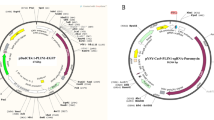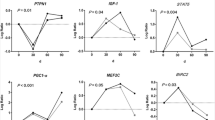Abstract
Glycogen synthase (GS) catalyzes the key step of glycogen synthesis and plays an important role in glycogen metabolism in liver and muscle. In this study, we cloned the cDNA and promoter sequences of porcine glycogen synthesis genes (GYS1 and GYS2). Expression analysis revealed that porcine GYS1 was highly expressed in the skeletal muscle and heart. GYS2 was expressed specifically in liver and subcutaneous adipose tissue. The expression level of GYS1 was up-regulated from proliferation to differentiation in the porcine satellite cells, and insulin did not significantly affect the transcription of GYS1. Insulin stimulated 72-h-differentiated satellite cells as indicated by decrease in phosphorylation of GS, but did not affect GYS1 transcription and total GS protein level, suggesting that the effect of insulin is primarily mediated via posttranscriptional control rather than regulated at the transcriptional level. Four single-nucleotide polymorphisms (SNPs) were detected in the promoter and cDNA sequences of porcine GYS1. Association analyses revealed that the GYS1 Hin6I and MvaI polymorphisms both had significant associations (P < 0.05) with pH of M. longissimus dorsi (pHLD), M. biceps femoris (pHBF) and M. semipinalis capitis (pHSC) at 45 min postmortem. These results provide useful information for further investigation on the function of glycogen synthase in porcine skeletal muscle.







Similar content being viewed by others
References
Kaslow HR, Lesikar DD, Antwi D, Tan AW (1985) L-type glycogen synthase. Tissue distribution and electrophoretic mobility. J Biol Chem 260:9953–9956
Bai G, Zhang ZJ, Werner R, Nuttall FQ, Tan AW, Lee EY (1990) The primary structure of rat liver glycogen synthase deduced by cdna cloning. Absence of phosphorylation sites 1a and 1b. J Biol Chem 265:7843–7848
Kaslow HR, Lesikar DD (1984) Isozymes of glycogen synthase. FEBS Lett 172:294–298
Browner MF, Nakano K, Bang AG, Fletterick RJ (1989) Human muscle glycogen synthase cDNA sequence: a negatively charged protein with an asymmetric charge distribution. Proc Natl Acad Sci USA 86:1443–1447
Manchester J, Skurat AV, Roach P, Hauschka SD, Lawrence JC (1996) Increased glycogen accumulation in transgenic mice overexpressing glycogen synthase in skeletal muscle. Proc Natl Acad Sci USA 93:10707–10711
Pederson BA, Chen HY, Schroeder JM, Shou WN, DePaoli-Roach AA, Roach PJ (2004) Abnormal cardiac development in the absence of heart glycogen. Mol Cell Biol 24:7179–7187
Pederson BA, Schroeder JM, Parker GE, Smith MW, DePaoli-Roach AA, Roach PJ (2005) Glucose metabolism in mice lacking muscle glycogen synthase. Diabetes 54:3466–3473
Larzul C, Lefaucheur L, Ecolan P, Gogue J, Talmant A, Sellier P, LeRoy P, Monin G (1997) Phenotypic and genetic parameters for longissimus muscle fiber characteristics in relation to growth, carcass, and meat quality traits in large white pigs. J Anim Sci 75:3126–3137
Ryu YC, Kim BC (2005) The relationship between muscle fiber characteristics, postmortem metabolic rate, and meat quality of pig longissimus dorsi muscle. Meat Sci 71:351–357
Fernandez-Figares I, Shannon AE, Wray-Cahen D, Caperna TJ (2004) The role of insulin, glucagon, dexamethasone, and leptin in the regulation of ketogenesis and glycogen storage in primary cultures of porcine hepatocytes prepared from 60 kg pigs. Domest Anim Endocrinol 27:125–140
Roach PJ, Cheng C, Huang D, Lin A, Mu J, Skurat AV, Wilson W, Zhai L (1998) Novel aspects of the regulation of glycogen storage. J Basic Clin Physiol Pharmacol 9:139–151
Gomis RR, Ferrer JC, Guinovart JJ (2000) Shared control of hepatic glycogen synthesis by glycogen synthase and glucokinase. Biochem J 351:811–816
Cohen P, Frame S (2001) The renaissance of GSK3. Nat Rev Mol Cell Biol 2:769–776
Hanashiro I, Roach PJ (2002) Mutations of muscle glycogen synthase that disable activation by glucose 6-phosphate. Arch Biochem Biophys 397:286–292
Mccue ME, Valberg SJ, Miller MB, Wade C, DiMauro S, Akman HO, Mickelson JR (2008) Glycogen synthase (GYS1) mutation causes a novel skeletal muscle glycogenosis. Genomics 91:458–466
Zuo B, Xiong YZ, Deng CY, Su YH, Wang J, Lei MG, Li FE, Jiang SW, Zheng R (2005) Polymorphism, linkage mapping and expression pattern of the porcine skeletal muscle glycogen synthase (GYS1) gene. Anim Genet 36:254–257
Zuo B, Yang H, Lei MG, Li FE, Deng CY, Jiang SW, Xiong YZ (2007) Association of the polymorphism in GYS1 and ACOX1 genes with meat quality traits in pigs. Animal 1:1243–1248
Fontanesi L, Davoli R, Nanni Costa L, Scotti E, Russo V (2003) Study of candidate genes for glycolytic potential of porcine skeletal muscle: identification and analysis of mutations, linkage and physical mapping and association with meat quality traits in pigs. Cytogenet Genome Res 102:145–151
de Koning DJ, Janss LL, Rattink AP, van Oers PA, de Vries BJ, Groenen MA, van der Poel JJ, de Groot PN, Brascamp EW, van Arendonk JA (1999) Detection of quantitative trait loci for backfat thickness and intramuscular fat content in pigs (sus scrofa). Genetics 152:1679–1690
Clop A, Ovilo C, Perez-Enciso M, Cercos A, Tomas A, Fernandez A, Coll A, Folch JM, Barragan C, Diaz I, Oliver MA, Varona L, Silio L, Sanchez A, Noguera JL (2003) Detection of QTL affecting fatty acid composition in the pig. Mamm Genome 14:650–656
Wang L, Lei M, Zuo B, Xu D, Ren Z, Xiong Y (2010) Multiple alternative splicing and differential expression of actinin-associated LIM protein (ALP) during porcine skeletal muscle development in vitro and in vivo. Meat Sci 84:655–661
Ortenblad N, Young JF, Oksbjerg N, Nielsen JH, Lambert IH (2003) Reactive oxygen species are important mediators of taurine release from skeletal muscle cells. Am J Physiol Cell Physiol 284:C1362–C1373
Livak KJ, Schmittgen TD (2001) Analysis of relative gene expression data using real-time quantitative PCR and the 2(-Delta Delta C(T)) method. Methods 25:402–408
Thomas JA, Schlender KK, Larner J (1968) A rapid filter paper assay for udpglucose-glycogen glucosyltransferase, including an improved biosynthesis of UDP-14C-glucose. Anal Biochem 25:486–499
Xiong YZ, Deng CY (1999) Principle and method of Swine Testing. Chinese Agricultural Press, Beijing
Liu BH (1998) Statistical genomics: linkage, mapping, and QTL analysis. CRC Press, New York
Skurat AV, Roach PJ (1995) Phosphorylation of sites 3a and 3b (Ser640 and Ser644) in the control of rabbit muscle glycogen synthase. J Biol Chem 270:12491–12497
Skurat AV, Roach PJ (1996) Multiple mechanisms for the phosphorylation of c-terminal regulatory sites in rabbit muscle glycogen synthase expressed in cos cells. Biochem J 313:45–50
Ros S, Garcia-Rocha M, Dominguez J, Ferrer JC, Guinovart JJ (2009) Control of liver glycogen synthase activity and intracellular distribution by phosphorylation. J Biol Chem 284:6370–6378
Mandard S, Stienstra R, Escher P, Tan NS, Kim I, Gonzalez FJ, Wahli W, Desvergne B, Muller M, Kersten S (2007) Glycogen synthase 2 is a novel target gene of peroxisome proliferator-activated receptors. Cell Mol Life Sci 64:1145–1157
Blais A, Tsikitis M, Acosta-Alvear D, Sharan R, Kluger Y, Dynlacht BD (2005) An initial blueprint for myogenic differentiation. Genes Dev 19:553–569
Liu J, Brautigan DL (2000) Glycogen synthase association with the striated muscle glycogen-targeting subunit of protein phosphatase-1. Synthase activation involves scaffolding regulated by beta-adrenergic signaling. J Biol Chem 275:26074–26081
Flotow H, Roach PJ (1989) Synergistic phosphorylation of rabbit muscle glycogen synthase by cyclic amp-dependent protein kinase and casein kinase I. Implications for hormonal regulation of glycogen synthase. J Biol Chem 264:9126–9128
Orena SJ, Torchia AJ, Garofalo RS (2000) Inhibition of glycogen-synthase kinase 3 stimulates glycogen synthase and glucose transport by distinct mechanisms in 3T3–L1 adipocytes. J Biol Chem 275:15765–15772
Rommel C, Bodine SC, Clarke BA, Rossman R, Nunez L, Stitt TN, Yancopoulos GD, Glass DJ (2001) Mediation of IGF-1-induced skeletal myotube hypertrophy by PI(3)K/AKT/mTOR and PI(3)K/AKT/GSK3 pathways. Nat Cell Biol 3:1009–1013
MacAulay K, Blair AS, Hajduch E, Terashima T, Baba O, Sutherland C, Hundal HS (2005) Constitutive activation of GSK3 down-regulates glycogen synthase abundance and glycogen deposition in rat skeletal muscle cells. J Biol Chem 280:9509–9518
Fernandez X, Tornberg E (1991) A review of the causes of variation in muscle glycogen content and ultimate pH in pigs. J Muscle Foods 2:209–235
Malek M, Dekkers JC, Lee HK, Baas TJ, Prusa K, Huff-Lonergan E, Rothschild MF (2001) A molecular genome scan analysis to identify chromosomal regions influencing economic traits in the pig. II. Meat and muscle composition. Mamm Genome 12:637–645
Immonen K, Puolanne E (2000) Variation in residual glycogen–glucose concentration at ultimate pH values below 5.75. Meat Sci 55:279–283
Kylä-Puhju M, Ruusunen M, Puolanne E (2005) Activity of porcine muscle glycogen debranching enzyme in relation to pH and temperature. Meat Sci 69:143–149
Acknowledgments
This study was supported by the grants from National Natural Science Foundation of China (31101699), the Key Project of National Basic Research and Developmental Plan (2006CB102102) of China, and National High Technology Research and Development Program (2006AA10Z1D6).
Author information
Authors and Affiliations
Corresponding author
Rights and permissions
About this article
Cite this article
Wang, L., Xiong, Y., Zuo, B. et al. Molecular and functional characterization of glycogen synthase in the porcine satellite cells under insulin treatment. Mol Cell Biochem 360, 169–180 (2012). https://doi.org/10.1007/s11010-011-1054-4
Received:
Accepted:
Published:
Issue Date:
DOI: https://doi.org/10.1007/s11010-011-1054-4




